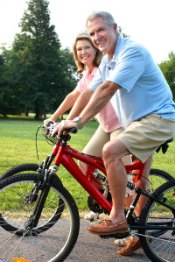Exercise just may be the magical key that unlocks happiness. Science tells us that exercise improves mood, fights depression, enhances quality of sleep, reduces stress and prevents disease. And according to a study published in Medicine & Science in Sports and Exercise, regular exercise can actually slow the aging process. If you are north of 40, keep your body strong and your energy up with our best exercise advice.
1. Choose something you love
If you see exercise as a chore, you are less likely to experience its benefits because you probably won’t stick with it in the long-term. Find an exercise you love and you don’t have to go in search of your motivation. No one has to drag you out of bed to do something you love. Experiment until you find a type of exercise that makes you happy.
The feel-good emotions can also help you stick with exercise long-term. In his book, Spark: The Revolutionary New Science of Exercise and the Brain, Dr. John Ratey, associate professor of psychiatry at Harvard, writes, “When we begin exercising, we almost immediately begin releasing dopamine, norepinephrine and serotonin. Those are all neurotransmitters that deal with feelings of reward, alertness, contentment and feelings of wellbeing.”
What to do: What exercise did you love as a child? Use your answer as inspiration to find an exercise you love as an adult. Ride a bike. Go for a hike. Swim laps or try water aerobics. Take up Pilates or the newest class at your gym.
2. Strength train
If making yourself exercise is a tall order, you might be immediately dismissive of strength training. However, “doing some form of strength training is mandatory as we age,” says national fitness trainer and founder of GetHealthyU Chris Freytag. “You can use dumbbells, resistance bands or your bodyweight, but muscle is the best way to rev up your metabolism as you age, and it’s something you have control over,” Chris says. “Muscle tissue can burn three to five times more calories than fat does. So the more muscle you have, the more calories you will burn, even while sitting,” Chris explains.
Strength training also slows bone and muscle loss as you age and keeps your body strong for everyday activities like taking the stairs and gardening. “As people age, there needs to be a stronger emphasis on functional movement and activities that are performed in daily life, such as squatting and pushing doors open,” says Mary Edwards, MS, director of fitness and a professional fitness trainer at Cooper Fitness Center. “Strength training helps increase muscle strength in the limbs and core, which are most important as people age. American College of Sports Medicine recommends strength training, especially for those ages 56 and up as important for maintaining functional movement, balance and power.”
You don’t need to invest much time with strength training to see results.
What to do: “Working with weights or your body weight for as little as 20 minutes for two to three days a week can crank up your resting metabolic rate over time,” Chris says. If you are using your body weight, try pushups, squats, lunges and planks.
3. Mix it up

- If you’re 40 years old or younger, devote 80 percent of your workout time to aerobic training and 20 percent to strength training.
- If you’re 41 to 50 years old, shift to 70 percent aerobic and 30 percent strength work.
- If you’re 51 to 60, do 60 percent aerobic exercise and 40 percent strength training.
- After you pass 60, divide your workout time more evenly between the two strategies – while still giving an edge to aerobic exercise, which provides the most health benefits: 55 percent aerobic work and 45 percent strength work.
What to do: Sometimes people are intimidated by the weight rooms or weight machines at gyms. You can strength train using your own body weight by holding planks, doing pushups and situps, wall-sits, lunges and squats. Or buy some hand weights and do some workouts at home. There are lots of online workouts both free and subscription-based.
4. Set a goal and track your progress
Write down the workouts you do on a calendar you see daily. Seeing your efforts in writing (or on your phone) gives you a boost and a sense of accomplishment. As happiness expert Shawn Achor says, “Happiness is the joy you feel striving toward your potential.” Use what you’ve done to fuel your motivation to do more. A goal can be a powerful reminder to exercise consistently.
What to do: Set a goal that holds you accountable. Maybe it’s signing up for a race, a desire to see muscle tone in the mirror, or working out a certain number of times per week. Keep going until you reach that goal.
5. Stretch
“After age 30, we start losing elasticity in our tendons and ligaments, making them tight,” Mary says. “As we age, stretching helps us maintain a good range of motion in the muscles, allowing joints to operate at normal functionality so they’re not limited.”
What to do: Make it a practice to stretch regularly when your body is already warmed up. American College of Sports Medicine recommends stretching muscles surrounding major joints two to three times per week, while holding each stretch for 60 seconds.
The best advice from all the experts? Keep moving. “As people age, the body changes and injury can occur, so dysfunction can creep in, Mary says. “Focus on what you can do, not what your limitations are.”
Sandra Bienkowski is a regular contributor to Live Happy and the founder and CEO of TheMediaConcierge.net.











